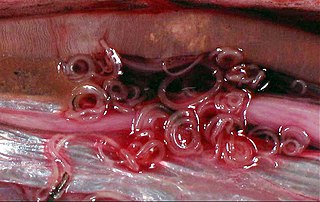Related Research Articles
Leptosomatidae is a family of benthic marine nematode worms.

Anisakis is a genus of parasitic nematodes that have life cycles involving fish and marine mammals. They are infective to humans and cause anisakiasis. People who produce immunoglobulin E in response to this parasite may subsequently have an allergic reaction, including anaphylaxis, after eating fish infected with Anisakis species.

Enoplea (enopleans) is a class, which with the classes Secernentea and Chromadorea make up the phylum Nematoda in current taxonomy. The Enoplea are considered to be a more ancestral group than the Chromadorea, and researchers have referred to its members as the "ancestrally diverged nematodes", compared to the "more recently diverged nematodes" of Chromadorea.

Harpacticoida is an order of copepods, in the subphylum Crustacea. This order comprises 463 genera and about 3,000 species; its members are benthic copepods found throughout the world in the marine environment and in fresh water. A few of them are planktonic or live in association with other organisms. Harpacticoida represents the second-largest meiofaunal group in marine sediments, after nematodes. In Arctic and Antarctic seas, Harpacticoida are common inhabitants of sea ice. The name Harpacticoida comes from the Greek noun harpacticon and the suffix -oid and means reminiscent of a predator.
Dauer describes an alternative developmental stage of nematode worms, particularly rhabditids including Caenorhabditis elegans, whereby the larva goes into a type of stasis and can survive harsh conditions. Since the entrance of the dauer stage is dependent on environmental cues, it represents a classic and well studied example of polyphenism. The dauer state is given other names in the various types of nematodes such as ‘diapause’ or ‘hypobiosis’, but since the C. elegans nematode has become the most studied nematode, the term ‘dauer stage’ or 'dauer larvae' is becoming universally recognised when referring to this state in other free-living nematodes. The dauer stage is also considered to be equivalent to the infective stage of parasitic nematode larvae.

Secernentea was a class of nematodes in the Classical Phylogeny System and is no longer in use. This morphological-based classification system has been replaced by the Modern Phylogeny system, where taxonomy assignment is based on small subunit ribosomal DNA.

The Chromadorea are a class of the roundworm phylum, Nematoda. They contain a single subclass (Chromadoria) and several orders. With such a redundant arrangement, the Chromadoria are liable to be divided if the orders are found to form several clades, or abandoned if they are found to constitute a single radiation.

Convolutindole A (2,4,6-tribromo-1,7-dimethoxy-N,N-dimethyltryptamine) is a brominated tryptamine alkaloid that was first identified in 2001 in Amathia convoluta, a marine bryozoan. Bryozoans are aquatic invertebrates that grow in colonies and may resemble corals.

The Anisakidae are a family of intestinal nematodes (roundworms). The larvae of these worms can cause anisakiasis when ingested by humans, in raw or insufficiently cooked fish.

The nematodes, roundworms or eelworms constitute the phylum Nematoda. They are a diverse animal phylum inhabiting a broad range of environments. Most species are free-living, feeding on microorganisms, but there are many that are parasitic. The parasitic worms (helminths) are the cause of soil-transmitted helminthiases.

Habronematoidea is a superfamily of spirurian nematodes in the large order Spirurida. Like all nematodes, they have neither a circulatory nor a respiratory system.
Enoplida is an order of nematodes. It is one of two orders in Enoplia, which is one of two subclasses in Class Enoplea.
Dorylaimia is a subclass of nematodes.
The Enoplia are a subclass of nematodes in the class Enoplea.

Cucullanus is a genus of parasitic nematodes. The genus includes more than 100 species.
Stilbonematinae is a subfamily of the nematode worm family Desmodoridae that is notable for its symbiosis with sulfur-oxidizing bacteria.
Araeolaimus elegans is a species of marine free living nematodes from the North Sea.
Araeolaimida is an order of marine free living nematodes.
Plectus parvus is a species of nematode (roundworm) found in freshwater and terrestrial environments. It has been sampled in Europe and New Zealand. Along with the similar nematode Panagrolaimus detritophagus, in 2018 it was the first species of multicellular eukaryote to be thawed into a living state after prolonged cryopreservation. Female worms of this species were found in Pleistocene permafrost in the Kolyma River lowland. They were mobile and ate, after being frozen for 30–40 thousand years.

Cystidicolidae is a family of spirurian nematodes. It was created by Skrjabin in 1946. All members of the family are parasites of fish.
References
- ↑ Sur quelques nématodes libres de la Mer du Nord, nouveaux ou peu connus. JG Man, Mem. Soc. Zool. France, 1888
- ↑ Additions to the littoral fauna of Rockall, with a description of Araeolaimus penelope sp. nov.(Nematoda: Axonolaimidae). PG Moore, Journal of the Marine Biological Association of the …, 1977
- Araeolaimus at WoRMS